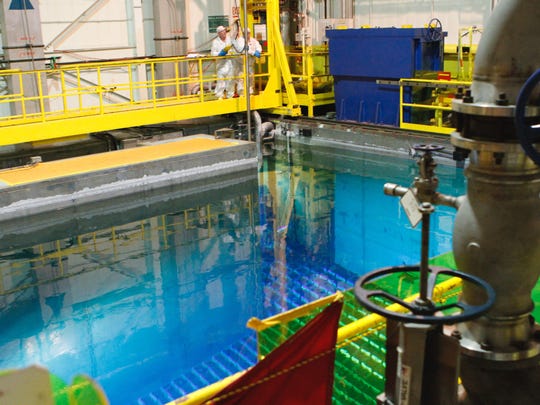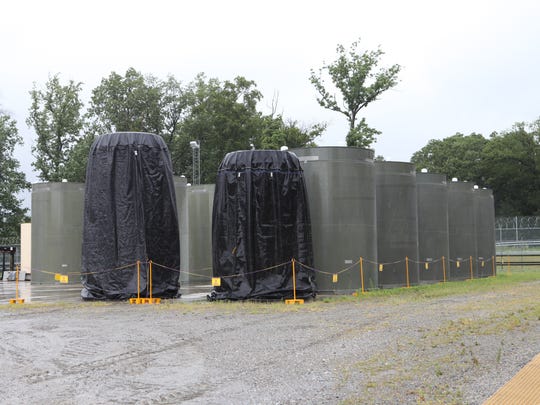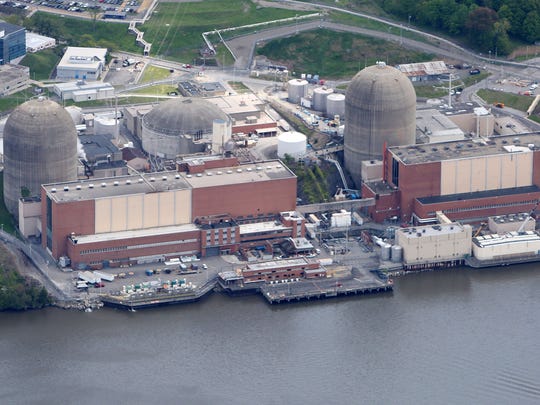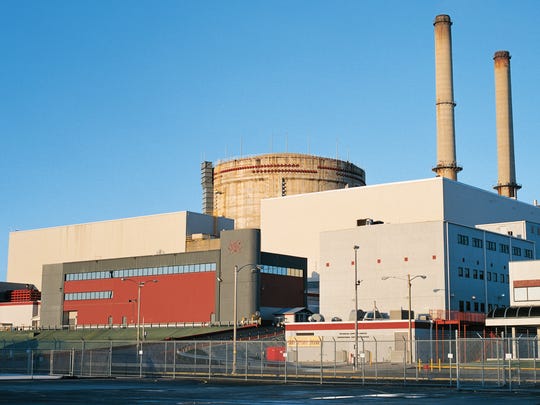What will happen to Indian Point spent nuclear fuel rods? Thomas Zambito for lohud reports. Ricky Flores/Frank Becerra Jr./lohud
The bold plan to rid the nation’s nuclear power plants of spent fuel that’s been piling up for decades is spelled out, down to the tiniest of details, in a 2002 Department of Energy report that took years to produce at a cost of billions of dollars.
It envisioned shipping the country’s nuclear waste on a spider-like configuration of barge, rail and truck routes to Yucca Mountain in the Mojave Desert, 100 miles northwest of Las Vegas.
For 15 years, the plans went nowhere as efforts to designate an underground repository for the nation’s nuclear waste foundered amid political opposition.
But in recent months, those routes have been debated anew as momentum builds in Congress for a way to rid the nation’s nuclear power plants of 76,000 metric tons of used fuel – enough spent fuel assemblies to cover a football field eight yards high if stacked end to end and side by side.

Among the report’s more controversial proposals is a plan to move spent fuel out of Indian Point in Buchanan — and 16 other power plants without direct access to railroads — by barge, down the Hudson River.
Over the course of decades, 58 shipments of spent fuel would be loaded on barges at Indian Point for the 42-mile trip down the Hudson at a leisurely 5 miles an hour pace, coursing under the Gov. Mario M. Cuomo Bridge and past New York City on the way to the seaport in New Jersey.
There, cement-and-steel casks of spent fuel, weighing as much as 100 tons, would be placed on rail cars for the 2,600-mile trip west to Yucca Mountain.
When the idea was first broached, state and local officials railed against the thought of nuclear waste floating down the Hudson.
“Any plan that involves the shipping of nuclear waste on a barge down the river past New York City raises enormous health, environmental and security concerns,” said then-Sen. Hillary Rodham Clinton, D-NY.
FormerNew Jersey Sen. Robert Torricelli also noted that New Jersey ports shouldn’t be used “as rest stops for nuclear material.”

New momentum for the plan
More than a decade later, the debate has taken on greater urgency. As more and more nuclear power plants either shut down or announce plans to close — victims of the cheap price of abundant natural gas — communities are anxious to get rid of spent fuel so they can find new uses for valuable property on waterfront locales that include the Pacific Coast, the Connecticut River and the Hudson River.
They accuse the federal government of failing to make good on a decades-old promise to find a place for the nation’s nuclear waste and say they should be compensated for being turned into “de-facto” nuclear storage sites.

Among them is Buchanan Mayor Theresa Knickerbocker, who holds out little hope that the political hurdles to shipping nuclear waste out of Indian Point can be overcome.
“Everyone is going to push back,” Knickerbocker said. “You’re going to get a lot of political pushback. It’s known as NIMBY (Not In My Backyard). If they haven’t resolved this in 30 years, you have to move on.”
The hardest pushback has come from Nevada, which has argued that the transportation of nuclear waste exposes communities across the country to unhealthy amounts of radiation.
When then-President George W. Bush designated Yucca as a repository in February 2002, a few months after the terrorist attacks on the Pentagon and the World Trade Center, then-Las Vegas Mayor Oscar Goodman told the Los Angeles Times that sending waste to Nevada will expose “millions of Americans in 43 states to potential nuclear holocaust.”Get the Daily Briefing newsletter in your inbox.
Start your day with the morning’s top newsDelivery: DailyYour Email
“All it takes is one terrorist with a TOW (anti-tank) missile obtained on the black market to take out a truck carrying this deadly substance, and we get Chernobyl in our backyard,” Goodman told the Los Angeles Times in February 2002. “This is the stuff of our worst nightmares.”
Energy Secretary Spencer Abraham countered, saying moving fuel by truck and rail was a better alternative to having it sitting in communities around the U.S.
Barge versus Tappan Zee
Spearheading Nevada’s opposition for nearly three decades has been Robert Halstead, the executive director of Nevada’s Agency for Nuclear Project in Gov. Brian Sandoval’s office. Halstead cites statistics suggesting that spent nuclear fuel would travel through 330 congressional districts in 44 states on the road to Yucca.
“We don’t have as many railroads as we used to have, so we’ve got a few that go cross country and they go through downtown Chicago, they go through downtown Salt Lake City,” Halstead said. “They go through downtown everywhere, just about, so the rail shipments really have a problem avoiding things.”
Some 15 years ago, Halstead traveled to Westchester County for a look at some of the proposed routes spent fuel would take out of Indian Point.

“At one point DOE had a plan on the table to make truck shipments out of Indian Point across the Tappan Zee Bridge,” Halstead said. “How crazy is that? That’s why they ended up considering a barge option.”
The precise transportation routes are still being studied, according to a follow-up to the 2002 DOE report released in 2008. That report designated rail cars as the preferred mode of transport and barges as an option for removing fuel from Indian Point and other facilities without access to rail. Instead of the Port of Jersey City, it designates the Port of Newark, some 55 miles away, as the site for loading the fuel onto railcars.
A DOE spokesman could not be reached for comment on why the port changed but, the 2008 report notes, the DOE considered a number of locations for the transfer to railcars.
Manna Jo Greene, the environmental director of Hudson River Sloop Clearwater, a watchdog group, questioned whether the canisters used to transport fuel out of Indian Point will be robust enough to withstand a mishap.
“I am aware that most of the nuclear facilities around the country want the waste off site but that is a double-edged sword in terms of the safety considerations about transportation,” Greene said.
Richard Webster, the legal director of Riverkeeper, the Hudson River environmental group, said that, with the uncertainty over naming a repository, the focus should be on improving or “hardening” on-site storage.
“It’s always about to happen and nothing happens,” Webster said. “All they really need to do is make sure fuel can be stored safely on the site.”
Indian Point’s fuel problem
At Indian Point, some 1,100 spent fuel assemblies are already stored in 34 cement casks on a cement pad on site and more will be added in the years to come after they are cooled in pools located next to the plant’s two reactors.

Greene thinks more could be done to disperse the casks of spent fuel across Indian Point’s entire 240-acre property so they’re not lined up like “bowling pins” on a pad. But such a plan would likely render the rest of the property unusable, a prospect that doesn’t sit well with communities around Indian Point looking for ways to generate revenue from the site.
Buchanan and the Town of Cortlandt, together with the Hendrick Hudson School District, stand to lose $32 million in annual tax revenues in the years after 2021, when Indian Point’s two reactors will be shut down.
“We don’t want it ever to become a distressed community,” Cortlandt Supervisor Linda Puglisi said at a meeting of the Indian Point Task Force last month.

Nevada opposes Yucca
In 2002, Bush selected Yucca Mountain as the nation’s first geologic repository for nuclear fuel and high-level radioactive waste. The decision followed years of study at a cost of $15 billion, most of that financed by surcharges in the electric bills of U.S. ratepayers.
It produced a 2002 report so meticulously detailed that the DOE calculated the number of nuclear fuel shipments needed to remove spent fuel from each power plant and just how many kilometers each would travel over urban, suburban or rural terrain.
From New York’s three upstate nuclear power plants – R.E. Ginna, Nine Mile Point and James A. FitzPatrick – more than 230 shipments of spent fuel would travel by rail through Pennsylvania and Ohio before heading west 2,500 miles.
Once at Yucca Mountain, a 150,000-acre site where the average annual precipitation is seven inches, tens of thousands of metric tons of spent nuclear fuel would be entombed in underground tunnels so that decaying radioactive isotopes could cool down over the course of thousands of years.
Nevada, led by then-Senate Democratic Majority Leader Harry Reid, railed against the Yucca plan and in 2010 the Obama administration withdrew an application to license Yucca that was before the Nuclear Regulatory Commission.
But in June, a bill to restart the Yucca licensing process, sponsored by Illinois Rep. John Shimkus, a Republican, passed the House Energy and Commerce committee by a 49-4 vote and could come up for a house vote as soon as this month.
The Trump administration has set aside $110 million to restart the Yucca Mountain licensing process and another $10 million to develop interim storage facilities.
Much is on the line.
The Government Accountability Office says the nation’s inventory of spent nuclear fuel is growing by 2,200 metric tons a year and is expected to total nearly 140,000 metric tons by 2067.
Keeping the fuel where it is has proved costly.
The federal government has already paid out more than $6 billion to compensate the owners of commercial reactors for reneging on a promise to take their waste by 1998. That figure is expected to grow by another $25 billion. In March, the state of Texas sued the DOE to force the agency it to live up to its promise to open Yucca.
Plant closings challenge small towns
Small towns in Vermont, Illinois and Wisconsin that once benefited from millions of dollars in property taxes generated by nuclear power plants are trying to come up with ways to close gaping holes in their budgets.
Several have thrown their support behind a bill in Congress that would set aside $100 million to compensate communities that are home to spent nuclear fuel until a permanent repository is opened.
After 30 years of false starts, groups on both sides of the debate question whether Yucca will ever open. Congressional watchdogs say that even if the House backs the Shimkus bill, success is not assured in the Senate. A companion bill has yet to be introduced.
They are, however, encouraged by the possibility of a compromise in the form of an interim storage site in New Mexico. The Nuclear Regulatory Commission is considering a license application submitted by New Jersey-based Holtec to develop the site. Shimkus’ bill provides at least $50 million in funding for a single interim site for the years 2020-2025.
“I’m hoping this bill is the start of a grand legislative compromise,” said Rod McCullum, the point person on used fuel issues for the Nuclear Energy Institute, a trade group for the owners of the nation’s commercial reactors. “The government is bleeding a ton of money in liability for not doing anything. But as you see plants like Vermont Yankee and Dover, Indian Point and Oyster Creek shut down, you’re seeing a lot more interest in moving used fuel.”

A looming transportation issue
Critics are concerned that even if a repository were to open in the next few years, little planning has gone into developing costly transportation routes.
Shimkus’ bill does not directly address the transportation issue except to require that any route to Yucca not pass through Las Vegas.
At a hearing last month, David Victor, a professor at the University of California at San Diego, urged members of a House subcommittee investigating the spent fuel issue to address the transportation issue.
“Under plausible yet optimistic scenarios, (interim storage) facilities could be open in the early 2020’s,” said Victor, who chairs a community panel overseeing the decommissioning process for the San Onofre Nuclear Generating Station (SONGS) in San Diego. “Spent fuel at SONGS (and many other sites) would be ready for shipment then. It would be a pity if all the work done to open storage and permanent disposal facilities falters for lack of attention to transportation.”
San Onofre shut down in 2012, leaving tens of thousands of spent fuel rods on a site overlooking the Pacific Coast.

Pacific surf rolls in under the nuclear reactors of the San Onofre Nuclear Generating Station in northern San Diego County on April 25, 2001. (Photo: DENIS POROY, ASSOCIATED PRESS)
“For years, Yucca Mountain has been a political lightning rod in ways that made it exceptionally difficult – at times, impossible – to move forward with that site,” Victor said. “The prospect of consolidated interim storage might prove politically more tractable because, when combined with consent-based siting, it allows communities to nominate themselves to become storage sites.”
California Rep. Darrell Issa, a Republican whose district includes San Onofre, co-sponsored the Shimkus bill and is a proponent of interim storage.
“I know for an absolute certainty taxpayers are already on the hook at this point for tens of billions of dollars over the next century, but this is a 10,000-year problem in need of a low-cost, safe solution,” Issa said at last month’s House hearing.
‘Screw Nevada 2’
Anti-nuclear groups fear that putting nuclear waste on the nation’s rails and rivers will expose greater numbers of people to dangerous amounts of radiation. They say creating interim sites will only exacerbate the problem since, eventually, the fuel will need to go to a permanent site.
“Moving it twice really doesn’t make sense,” said Greene, Clearwater’s environmental director.
The Maryland-based anti-nuclear group, Beyond Nuclear, has countered the Shimkus’ bill by highlighting the impact it could have on communities across the U.S.
“We used to use the slogan ‘When it comes to nuclear waste transportation, we all live in Nevada,’” said Kamps. “Most of the country is going to be impacted by these shipments whether it’s by rail, truck or barge.”
Halstead recently reprised a phrase adopted decades ago when Nevada was trying to head off plans for Yucca Mountain.
“They hate it when I say this is ‘Screw Nevada 2’,” Halstead says.
Nuke fuel movements
Nuclear Energy Institute’s McCullum says he’s unpersuaded by such arguments. He says hundreds of shipments of Navy fuel have criss-crossed the country for decades on the way to sites in Georgia and Idaho.
The NRC says 1,300 spent fuel shipments have been completed safely in the United States over the past 35 years. Four were involved in accidents but none resulted in the release of radioactive material, the commission notes.
“Transportation as a problem is really a red herring,” McCullum said. “It’s something that the anti-nuclear establishment and to an extent the Nevada opposition has used as a lever to try to gain support. Certainly, if you’re going to vote against Yucca Mountain because Harry Reid is the Senate Majority leader and you don’t want to tell your constituents you’re voting to strand nuclear waste in your community, you’re going to explain your vote by saying ‘Well I don’t think the transportation is safe.’ That’s politics.”

The NRC, which regulates civilian use of radioactive materials, works closely with the Department of Transportation to coordinate a plan for the safe transport of spent fuel. It requires that casks be constructed with walls of steel and shielding materials five to 15 inches thick and be able to survive tests involving impact, puncture, fire and submersion in water. Rail containers can weigh as much as 150 tons and can carry up to 20 tons of spent fuel.
A 2016 study done for the DOE by Oak Ridge National Laboratory in Tennessee found that there have been 25,400 shipments – totaling roughly 87,000 metric tons – of spent fuel worldwide without injury or loss of life due to radioactive material.
Meantime, as the debate over a permanent repository continues in Congress, Puglisi and others are pushing for state legislation that would give towns the ability to tax spent fuel.
“We need to be able to assess them as a ratable,” Puglisi said during the task force meeting last month.
Assemblywoman Sandy Galef, D-Ossining, is drafting a bill that would allow towns to classify spent fuel rods as real property for taxing purposes.
“Having the spent fuel there intrudes on our ability to use the site for other uses,” Galef said. “I think the people who live around the plant would like it to disappear and go someplace else.”
The Entergy owned Vermont Yankee Nuclear Power Plant in Vernon, Vermont closed in late 2014. Hear how it changed the town as various community members reflect on the closing. Mark Vergari/lohud
By Thomas C. Zambito
Source: https://www.lohud.com/story/news/investigations/2017/10/11/nuclear-waste-indian-point/713534001/





